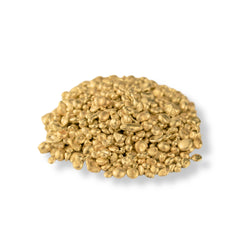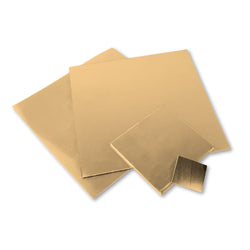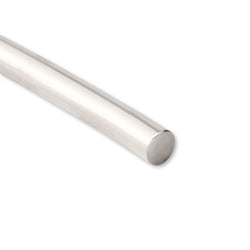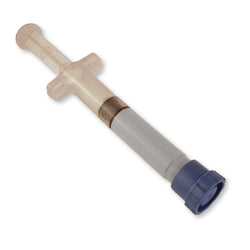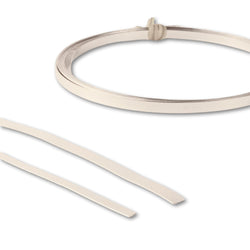Tillverkade metaller
Australiska smycken
Vår kollektion går utöver att bara leverera metaller; det handlar om att ge en grund för kreativitet och spetskompetens inom hantverk. Vi tillgodoser alla aspekter av din smycketillverkningsprocess med vårt premiumsortiment:
- Gjutkorn: Konstruerad med professionellt hantverk i åtanke, vår gjutsäd spänner över ett spektrum av ädla metaller, inklusive 9 karat, 14 karat och 18 karat gult, vitt och roséguld, såväl som fint silver, sterling silver och mer exotiska ädelmetaller som platina och palladium. Varje sats är noggrant testad för renhet, vilket säkerställer att dina gjutna delar uppvisar både hållbarhet och lyster.
- Plåt: Utforska vårt urval av premiumplåt, perfekt för tillverkning, formning, gravering, stämpling och efterbehandling. Från den formbara skönheten i massivt guld till glansen av sterling silver uppfyller våra ark dina olika hantverkskrav med oöverträffad kvalitet.
- Smycketråd: Böj, linda vrid och forma till ditt hjärta med vår elastiska smycketråd. Tillgängliga i en mängd olika former som fyrkantiga, halvrunda, rektangulära, tvinnade och mer, kommer våra kablar i olika mått för att stödja intrikata design och strukturell integritet.
- Rör: Idealiskt för att skapa dimensionella element, våra rör finns i legeringar som gult och vitt guld, silver och basmetaller inklusive mässing och koppar. De erbjuder en mångsidig bas för inställningar, ramar eller unika geometriska accenter i ditt smyckestillverkning.
- Löd: Vårt lödsortiment levererar pålitliga skarvar med en rad flödestemperaturer och sammansättningar för att matcha metallerna i ditt projekt. Välj från lätt till hårt löd för att skapa bestående bindningar i dina bitar med minimal färgskillnad.
- Strip: Låt din kreativitet flöda med vårt urval av remsor, inklusive ram, galleri och dekorativa alternativ. Tillgängliga i en rad metaller och mönster, de är idealiska för att lägga till utsmyckade kanter, ramar eller texturerade utsmyckningar till dina smycken.
- Kedja: Från klassiska kabelkedjor till utarbetade figaro- och kantdesigner, vårt urval inkluderar färdiga halsband och armband samt kedjerullar för anpassade längder. Tillverkade av massivt sterlingsilver och 9 karat guld, ger dessa kedjor en robust och elegant grund för hängen, berlocker, eller kan stå ensamma som ett statement.
Som juvelerare vet du vikten av att börja med de bästa. Våra tillverkade metaller är byggstenarna som används av de mest prestigefyllda juvelerarna globalt, vilket försäkrar dig om högsta standard. Med våra material har ditt hantverk inga gränser – släpp lös fantasin och låt de finaste metallerna forma framtiden för dina mönster.
Vanliga frågor
En "legering" är en kombination av metaller som smälts samman för att förbättra eller förändra deras egenskaper för specifika användningar.
Vid smyckestillverkning skapas legeringar för att öka styrkan, hållbarheten och färgen hos ädla metaller.
Till exempel är rent guld (24 karat) för mjukt för vardagsbruk, så det är legerat med metaller som koppar och silver för att skapa 18 karat guld, som är starkare och lämpligt för fina smycken.
Legeringar kan också påverka metallens smältpunkt, formbarhet och utseende, vilket ger juvelerare en mängd olika material för att passa olika designbehov.
Fina smycken är vanligtvis tillverkade av högkvalitativa, ädla metaller som erbjuder både skönhet och motståndskraft.
Framträdande bland dessa är 18 karat gult guld och 18 karat vitt guld, som båda kombinerar rent guld med andra metaller för att uppnå sin distinkta färg och styrka.
Platina är en annan stöttepelare i fina smycken på grund av dess renhet, densitet och den ljusa, vita glansen som inte bleknar eller mattas.
Dessa metaller värderas för sin långa livslängd, hypoallergena egenskaper och hur de förstärker briljansen hos ädelstenar.
När du skapar smycken är det tillrådligt att undvika metaller som är benägna att korrosion, lätt mattas eller kan orsaka allergiska reaktioner.
Metaller som nickel och bly undviks ofta på grund av deras potential för allergiska reaktioner.
Vissa legeringar som innehåller dessa metaller kan vara mindre önskvärda för dem med känslig hud.
Det är viktigt att använda högkvalitativa metaller eller de som är belagda för att förhindra direkt hudkontakt för bärbara smycken, vilket säkerställer lång livslängd och komfort.
En mängd olika metaller används vid smyckestillverkning för att tillgodose olika stilar, budgetar och designkrav.
Populära val inkluderar silver, känt för sin prisvärdhet och mångsidighet; guld i olika karat och färger för sin glänsande dragningskraft; platina för dess hållbarhet och hypoallergena egenskaper; och koppar och mässing för deras unika färger och kostnadseffektivitet.
Varje metall tillför sina egna egenskaper till ett smycke, vilket möjliggör ett brett spektrum av kreativa uttryck.
Solida guldlegeringar, inklusive 9 karat, 14 karat och 18 karat i gult, vitt och roséguld, erbjuder juvelerare en blandning av hållbarhet, bearbetbarhet och estetisk tilltalande.
Varje karat ger en annan renhetsnivå, med högre karat som innehåller mer guld och ger en rikare färg.
Solida guldlegeringar säkerställer också att skapelser är hypoallergena och behåller värdet över tid, vilket gör dem idealiska för högkvalitativa arvegods.
Casting grain refers to small, granulated pieces of metal that are melted down and used in the casting process to create jewellery. These grains are typically made from precious metals such as gold, silver, platinum, and palladium. In jewellery making, casting grain is melted in a crucible and then poured into moulds to form custom designs, which are then sanded, polished, and finished to create the final piece.
The best metals for casting fine jewellery include 9ct, 14ct, and 18ct gold (in yellow, white, and rose variations), sterling silver, fine silver, platinum, and palladium. These metals offer excellent durability, lustre, and resistance to tarnishing, making them ideal for high-quality, long-lasting jewellery.
Choosing the right casting grain for your project involves considering the type of jewellery you are making, the desired finish, and the metal's properties. For intricate designs, opt for a finer grain that melts evenly and produces a smooth finish. Additionally, consider the alloy and its colour, such as yellow, white, or rose gold, to match the aesthetic of your design.
Yes, you can mix different metals in casting grain to create unique alloys with distinct colours and properties. For example, mixing fine gold with copper produces rose gold, while adding silver or palladium to gold can create white gold. However, it’s essential to understand the melting points and compatibility of the metals to ensure a successful alloy.
The best thickness of sheet metal for stamping jewellery typically ranges from 24 to 20 gauge (0.5mm to 0.8mm). Thicker metal (around 0.8mm / 20 gauge) provides more durability and is less likely to warp, making it ideal for heavier or more substantial pieces. Thinner metal is easier to work with and is suited for detailed designs.
To cut sheet metal for jewellery making without damaging it, use a jeweller's saw with a fine blade or precision metal shears. Ensure the metal is stabilised while cutting, and use smooth, controlled movements. After cutting, use a file to smooth the edges and remove any roughness to prevent injury and improve the final finish.
Fine silver is 99.9% pure silver, making it softer and more malleable, ideal for delicate work and enamelling. Sterling silver, on the other hand, is an alloy consisting of 92.5% silver and 7.5% other metals, usually copper, which makes it stronger and more durable for everyday wear. Sterling silver is more commonly used for jewellery that requires greater strength and resilience.
To shape and form sheet metal for custom jewellery designs, use tools such as mandrels, hammers, and pliers. Annealing the metal (heating it to make it more pliable) helps achieve complex shapes. Once shaped, smooth the edges with files and sandpaper, and use a polishing cloth to give the metal a finished shine.
Jewellery wire is a type of metal wire used in various aspects of jewellery making, including creating loops, wrapping stones, forming chains, and making clasps and findings. Available in different gauges and shapes, jewellery wire is essential for both decorative and structural elements in jewellery design.
Choosing the right gauge of jewellery wire depends on the intended use. For example, 20-22 gauge wire is ideal for making loops and links, while 24-26 gauge wire is best for intricate wrapping and beadwork. Thicker wire, such as 18 gauge, is suitable for structural components like frames and clasps.
Choosing the right gauge of jewellery wire depends on the intended use. For example, 20-22 gauge wire is ideal for making loops and links, while 24-26 gauge wire is best for intricate wrapping and beadwork. Thicker wire, such as 18 gauge, is suitable for structural components like frames and clasps.
Gold jewellery wire offers a luxurious finish, resistance to tarnishing, and high durability, making it ideal for fine jewellery. It also maintains its value over time. Silver wire, while more affordable, is prone to tarnishing but is more affordable and easier to work with due to its softness and flexibility.
Yes, jewellery wire can be used for structural components in jewellery, such as making frames, clasps, and settings. Thicker gauges (18-20) provide the necessary strength for these elements, ensuring durability and stability in the final piece.
To prevent kinks and bends in jewellery wire, work slowly and use the right tools, such as nylon-jaw pliers, which are gentle on the wire. Also, keep the wire straight and avoid twisting it unnecessarily. Annealing the wire before working can also help reduce stiffness and make it more pliable.
The best types of jewellery wire for wire wrapping are soft or half-hard wires in gauges ranging from 24 to 20. Sterling silver, fine silver, and copper wires are popular choices due to their flexibility and ability to hold intricate shapes without breaking
Tube metal is hollow metal tubing used in jewellery making to create bezel settings for stones, form structural components in rings, or serve as decorative elements in necklaces and bracelets. It can also be used to create hinge components, frameworks, incorporate geometric designs.
Selecting the right tube size for your jewellery project depends on the design and the elements you're creating. For example, smaller tubes are ideal for fine details and stone settings, while larger tubes can be used for structural components or bolder, more prominent designs. Consider the diameter and wall thickness based on the desired durability and aesthetic.
Solder is a metal alloy used to join pieces of metal together in jewellery making. It is essential for creating strong, durable bonds between components without compromising the jewellery’s appearance. Solder is available in different types (easy, medium, hard) with varying melting points, allowing jewellers to choose the appropriate type for their project.
To avoid colour differences when soldering different metals, use a solder that closely matches the metals you are working with. For example, use silver solder for silver pieces, yellow gold solder for yellow gold jewellery or rose gold solder for rose gold repairs. Additionally, ensure the metals are clean and free from oxidation before soldering to achieve a seamless joint.
Choosing the right bezel strip for gemstone setting involves selecting the appropriate thickness and height based on the size and shape of the gemstone. Aim to match the bezel width to the stone’s height. Thinner strips are better for smaller, delicate stones, while thicker strips provide more security for larger stones. The bezel strip should also match the metal of the jewellery for a cohesive look.
To add texture and detail using embossed strips, choose strips with patterns or embossing that complement your design. Solder the strips onto your jewellery piece to create borders, frames, or other decorative elements. You can also use texture hammers or embossing tools to create additional patterns on plain strips.
Selecting the right chain for a custom necklace design depends on the style and weight of the necklace. For delicate designs, opt for a fine Cable or Wheat chain. For heavier pendants, a stronger chain like a Curb or Cuban link is ideal. Consider the chain's length, thickness, and metal to ensure it complements the overall design.
Yes, you can solder chains to create custom lengths for jewellery. Use a micro welder or jeweller’s torch, solder, and flux to carefully join the ends of the chain, ensuring a seamless connection. This allows you to tailor the chain length to fit specific designs or customer preferences.
Solid gold chains offer several benefits over gold-plated chains, including greater durability, resistance to tarnishing, and long-term value. While gold-plated chains have a thin layer of gold over a base metal, solid gold chains are made entirely of gold, making them more robust and able to withstand daily wear without losing their lustre.
To choose the right chain thickness for bracelet designs, consider the style and durability required. Thicker chains (like Cuban or Curb chains) are ideal for sturdy, statement bracelets that need to withstand daily wear. For a more delicate or intricate design, opt for a finer chain, such as a Cable or Figaro chain. The thickness of the chain should also complement any charms or decorative elements you plan to add, ensuring the bracelet remains balanced and visually appealing.
You can buy high-quality fabricated metals for jewellery making from specialised jewellery supply stores, both online and in physical locations. Stores like Ore Metals offer a wide range of products, including casting grain, sheet metal, jewellery wire, tubes, solder, strips, and chains in various precious and base metals. Shopping online gives you the advantage of comparing products, reading customer reviews, and accessing a broader selection of materials.

